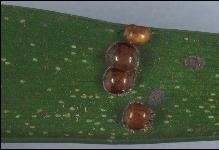
by Eddie Powell | May 8, 2015

Florida soft scale. Photo credit: UF/IFAS.
Scale insects are one of the most serious problems homeowners face on ornamentals this time of year. The most common are armored scale, soft scale, and mealybugs. They cause damage by sucking plant fluids from the leaves, stems, and sometimes roots. Some species feed on the underside of the leaves which can appear as yellowing spots or chlorotic lesions. Heavy infestations can cause extensive leaf yellowing, premature leaf drop, branch dieback, and plant death.
The life cycle starts when the eggs are laid beneath a waxy covering or beneath the adult female. After the eggs hatch two to three weeks later, the nymphs (crawlers) move around the plant until they find a suitable feeding site. Crawlers then insert their straw-like mouthparts into the plant and begin to feed and grow. The male often develops wings and flies to locate a mate.
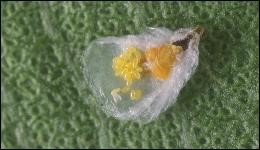
Armored scale nymphs. Photo: UF/IFAS.
Armored scale is distinct from other types of scales because they secrete a waxy covering over their body that is not attached to the body. The scale lives and feeds under this covering ranging 1/16 to 1/8 inch in size. They can be any color or shape, depending on the species. Armored scale does not produce honeydew.
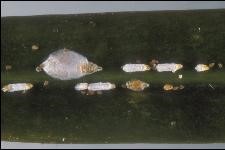
Armored scale. Photo credit: UF/IFAS.
Soft scale also secretes a waxy covering but it is attached to the bodies. Soft scales vary in color, size, and shape. They are circular shaped and range from 1/8 to ½ inch in diameter. Because they consume so much plant sap, they excrete a lot of sugary liquid called honeydew. Honeydew is the sticky liquid found on the leaves.
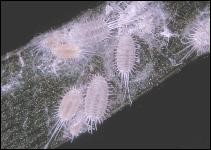
Mealybugs. Photo credit: UF/IFAS.
Mealybugs are soft bodied insects that are often covered with cottony white filaments. They are 1/8 inch in size and feed on all parts of plants. Injured plants have discolored, wilted, and deformed foliage.
Sooty mold is caused when mealybugs and soft scales excrete large amounts of honeydew which provides an excellent medium for the growth of the black fungus. Sooty mold is not only unattractive; it slows down the growth of the plant as it interferes with photosynthesis. Over time, with the control of the insect population, the sooty mold will weather away. Ants can also play a big factor in controlling sooty mold as they will feed on the honeydew.
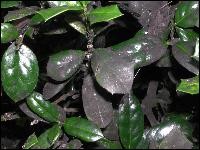
Sooty mold. Photo credit: UF/IFAS.
To control scale and mealybugs, avoid over-fertilizing and monitor your plants often. If the infestation becomes over-bearing, spray a fine mist of Horticultural Oil on the foliage. Avoid spraying in the summer heat because of damaging foliage. Other chemicals that can be used if necessary are Sevin dust and Malathion.
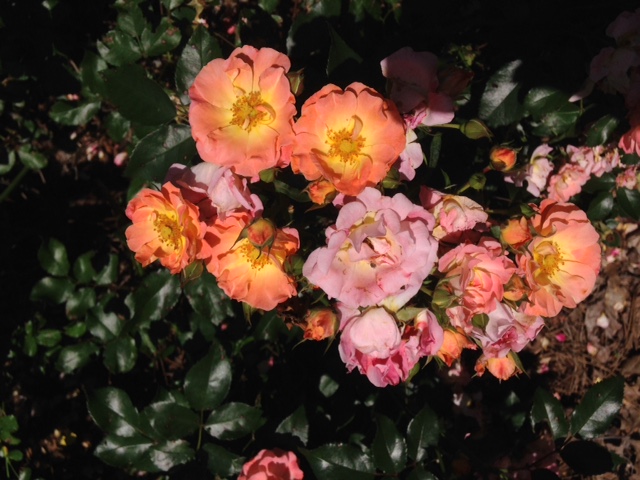
by Julie McConnell | May 6, 2015
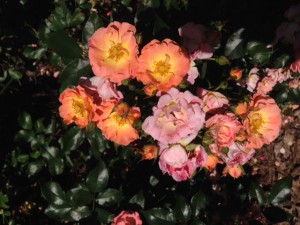
Peach Drift® Rose blooming in Quincy at the UF/IFAS NFREC Photo: J.McConnell, UF/IFAS
Growing roses in the South can have challenges and many gardeners think that they are just too high maintenance to plant. Plant developers are aware of this opinion and have worked to develop low maintenance roses that can make a novice gardener look like a pro.
The trend in horticulture is to develop and release plant series where closely related plants have similar characteristics but offer some diversity such as different flower color and size. A new series that is performing well in North Florida is Drift® Groundcover Roses. Available with flower colors ranging from white, yellow, pink, apricot, to red. All exhibit a low growing habit and will remain under three feet tall and spread up to four feet wide. Flowers are born in dense clusters for most of the year, only taking a break in the winter months.
Although not completely disease free, these roses do show resistance to rust, powdery mildew, and black spot which are common problems with roses. Deadheading is not necessary, but can be done to increase bloom and keep plants looking tidy. One of the best characteristics of the Drift® Groundcover Rose series is that they don’t get very tall, so they fit in small spaces. If you are looking for incredible color in a sunny site with limited space give this series a try.
Although low maintenance, roses do still require some attention, for more information read Growing Roses in Florida.
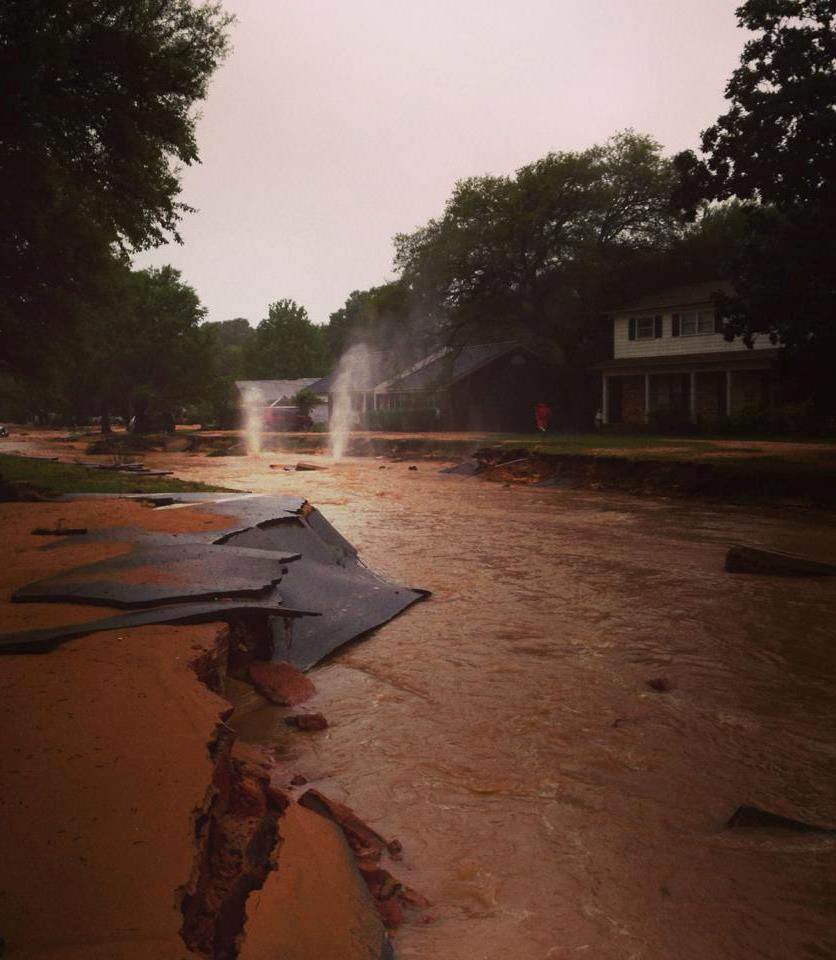
by Carrie Stevenson | May 6, 2015
Just over a year ago, southwest Alabama and northwest Florida experienced a devastating storm that left hundreds without access to their homes and businesses, flooded out and stranded by a hurricane-force storm that didn’t come with the luxury of a week’s warning. Rainfall records in Pensacola go back to 1879, and the April 29-30 storm broke them all, estimating just over 20 inches over the two days. Not only was the rainfall heavy, but the torrent was high in both velocity and volume—at one point, a mind-boggling 5.68 inches fell in the span of one hour. That’s half the annual rainfall of many cities in California and Texas!
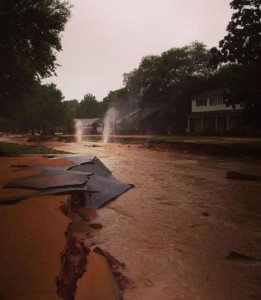
A residential street in Pensacola became a raging river a year ago during the torrential floods, putting dozens of people out of their homes. Photo credit: Carrie Stevenson UF/IFAS Extension.
With every dark storm cloud comes a silver lining, though, and just like the millions pumped into our regional economy from oil spill-related fines, the April 2014 floods have awakened a “greener” ethic among many residents, business owners, and politicians. According to a study just released by an environmental consulting firm, when asked about infrastructure changes and improvements to flooding and stormwater, attendees at community meetings overwhelmingly preferred “low impact” solutions such as expanded green space, cisterns, rain gardens, and stream restoration to “hard” structures such as bigger underground pipes and more pumps. While traditional engineering infrastructure is still crucial to a community that must maintain roads, stormwater ponds, and buildings, I find it encouraging that residents are interested in trying different techniques that have proven successful both here and in other parts of the world.
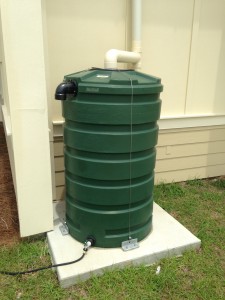
The new Langley Bell 4-H Center has four large rain barrels around the building, used to collect roof runoff for landscape design. Photo credit: Carrie Stevenson UF/IFAS Extension.
So, how does one prepare for unexpected rain and floods? The first thing is to realize that northwest Florida receives the most annual rainfall (over 60”) of any region of the state, and sometimes it seems to come down all at once. Preparing landscapes to handle both frequent and heavy rains is an important place to start. This article will begin a series of articles delving into those “low-impact” stormwater management techniques that can help lessen the impact of the intense storms we experience here in northwest Florida. Many of these practices, such as creating mulch pathways, harvesting rainwater, and installing shoreline vegetative buffers, can be implemented by individual homeowners and help reduce the impact of flooding on a neighborhood and city-wide level
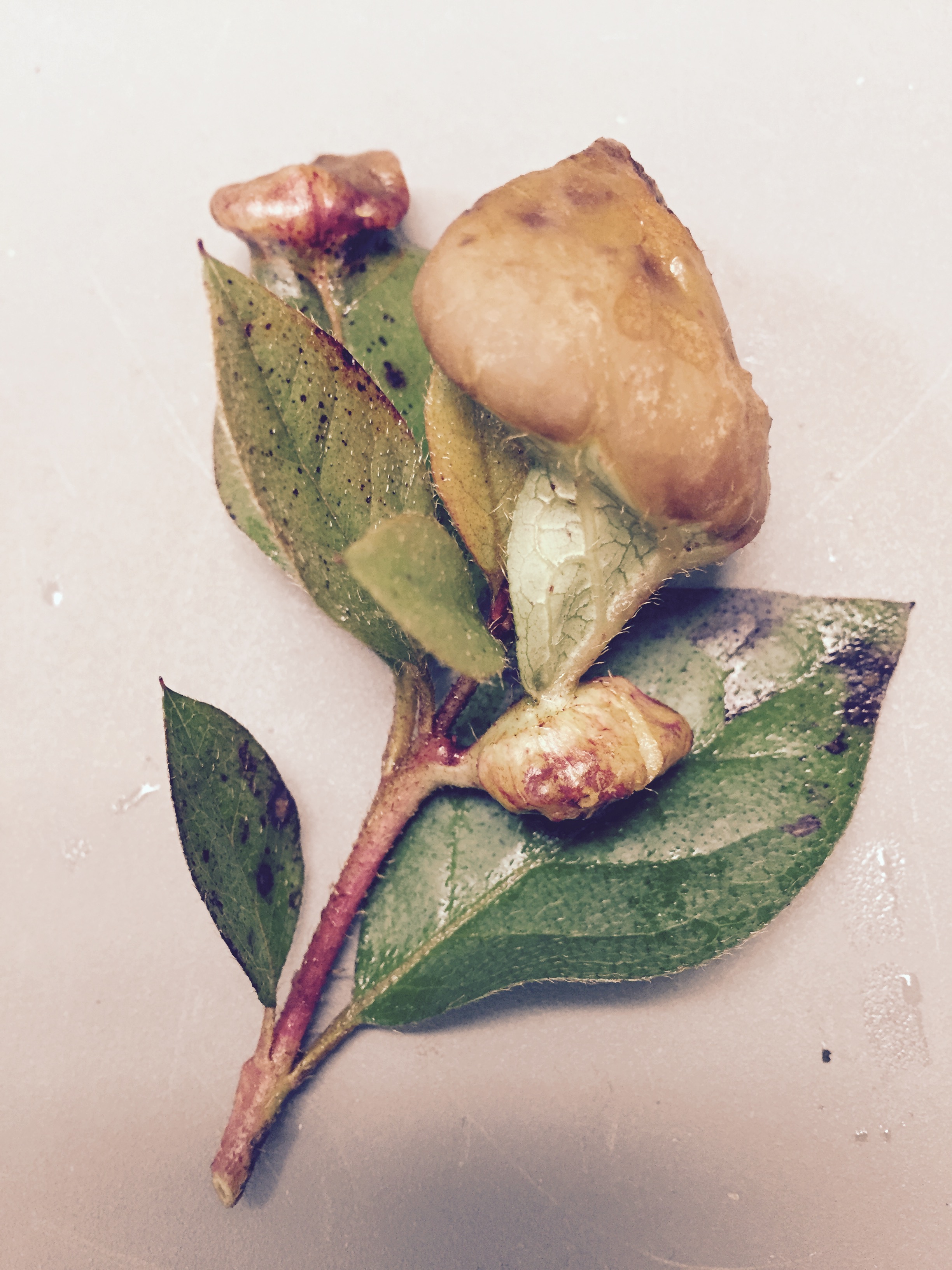
by Mary Salinas | Apr 28, 2015
Fleshy distortions are appearing on some azaleas this time of year. What is responsible for this? A fungus, Exobasidium vaccinia, likes our cool, wet spring weather and infects azalea leaves and flower petals. This disease likes a cool, wet, shady and protected environment.
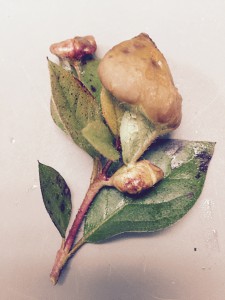
Azalea gall. Photo credit: Mary Derrick, UF/IFAS Extension.
The infection causes the plant to form large, fleshy, distorted tissues known as galls. The galls produce a white powdery coating that is capable of producing more spores that will continue to cause new infections if left on the bush. The gall will eventually turn dry and brown and fall to the ground. Sometimes there are only a few leaves infected or there may be quite a few on a bush.
Not to worry – this is not likely to cause significant harm to your azalea. The best plan of action is to remove the galls as soon as possible and dispose of them in the trash or burn them to prevent reinfection of your plants. Avoid any irrigation that sprays water onto the leaf surfaces as the moisture creates a favorable environment for disease. Once you see this gall forming, there is no chemical control that is effective.
For more information on caring for your azalea:
Azaleas at a Glance
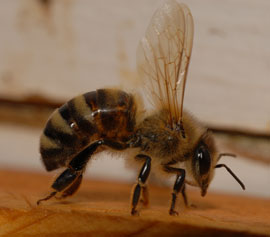
by Sheila Dunning | Apr 28, 2015
Bees have been disappearing at an alarming rate and continue to vanish without a trace. Why should anyone care? Well, they matter a lot more than most people think. Bees are the overwhelmingly dominant pollinator for most food crops. Native bees in the United States are responsible for pollinating over $15 billion worth of agricultural commodities annually. However, native bee populations are in decline due to habitat loss. At the same time, managed colonies of European honey bees have suffered a 50% decline over the past few decades. Numerous other pollinating insects are facing the same fate.

European honey bee. Photo credit: UF/IFAS.
As the spring planting season is upon us, it’s exciting to think about all the wonderful produce we will have this summer. But, without pollinators many of these crops would not be available. The majority of fruit and vegetable food sources we eat are dependent on insect pollinators. One of every three bites of food Americans consume comes from a plant visited by bees or other pollinators.
As declining numbers of farmers work to meets the need of increasing populations, they are forced to make choices on alternative to chemicals for pest control. “Good bug blends” of flowers can help attract pollinators as well as beneficial insects that suppress harmful pests. Establishment of these meadows can be done on a small or large scale and in any habitat. One approach to “bring back the pollinators” is to intercrop with blooming plants that attract insects. Selecting a diversity of plants with different flower sizes, shapes and colors, as well as various plant heights and growth habits, will encourage the greatest numbers of pollinators. It is important to provide a continuous source of pollen and nectar throughout the growing season. At minimum, strive for three species to be blooming at any one time; the greater the diversity the better.
To enhance the garden, choose flowering plants that also provide shelter for beneficial insects. Many companion plants are suitable habitat for predators and parasitoids. Research in Florida has demonstrated that predatory minute pirate bugs can build to high numbers in sunflowers. The favorite food of minute pirate bugs is Western flower thrips. So, planting sunflowers on the perimeter of vegetable crops, such as peppers, can greatly reduce the damage caused by the thrips. Similar results were found with the planting of sorghum to attract beneficial mites and intercropping with buckwheat to house syrphid flies and parasitoid wasps. The garden vegetables experienced fewer spider mite, whitefly and aphid problems. Crimson clover, Hairy vetch and cosmos are other annual seed crops that can aid in attracting pollinators and harboring beneficial insects.
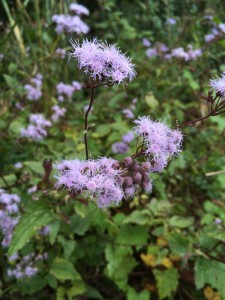
Blue Mistflower. Photo Credit Mary Derrick, UF / IFAS Extension.
Insectary meadows can be created in the landscape and along roadways, not just in the garden. For more permanently planted areas, native wildflowers, grasses and woody plants serve as larval host plants for butterflies, and also provide nesting and overwintering sites for bumble bees, predacious beetles and other beneficial insects. Native perennial wildflowers such as blanketflower, tickseed, black-eyed Susan, partridge pea, narrowleaf sunflower, milkweed, beebalm, goldenrod and silkgrass can be installed in the spring as potted plants or seeded in the fall. Seeds require exposure to cold temperatures and damp conditions before germination can occur. In Florida, the best time is November to February.
Though grasses do not offer nectar or high-quality pollen, it is often useful to include at least one native bunch grass or sedge. Short, clump-forming grasses are preferable to large, spreading grasses. Hedgerow planting of woody species is a way to provide winter-blooming plants vital for supporting pollinators. Woody plants and grasses provide more than forage for pollinators, as many native bee species nest in the stems of plants or in the undisturbed ground underneath plantings. Suitable grasses include: beaked panicgrass, purple lovegrass, Muhly grass, broomsedge,little bluestem, wiregrass and toothache grass. Favored woody species that make good “beetle banks” include: fetterbush, American beautyberry, saw palmetto, Chickasaw plum, red maple, sparkleberry, Dahoon holly, redbud, blackgum, magnolia, buttonwood and sourwood.
Regardless of whether the objective is to establish herbaceous or woody vegetation, the time and effort spent on eradicating undesirable plants prior to planting will result in higher success rates in establishing the targeted plant community. Choose level, open sites that receive full sunlight and have limited weed populations. If perennial weeds are a problem, the use of herbicides that have no soil residual (e.g. glyphosate) may be necessary.
For more information on establishing planting for pollinators visit: www.xerces.org/pollinator.
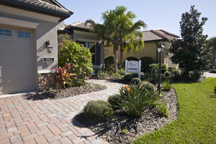
by Roy Carter | Apr 27, 2015

UF/IFAS Photo: Tyler Jones.
Most people know that an attractive landscape adds to the value of a home. For most of us, the landscape also represents a hefty investment of money, time and work so it’s important to know enough about landscape design to do the job right.
An important step in developing an attractive landscape is spacing plant materials correctly. Plants should be placed in the landscape in relation to each other, and with some understanding of their ultimate height, spread, and growth rate. However, the endless variety of plant sizes and shapes can easily complicate this matter for the home gardener.
How the plant is used in the landscape will determine its shape to a large extent. For example, if a plant is part of a hedge row, it should be placed close to the other plants so that in a few years, all of them grow together. If you want to retain the individual shape of each plant space the plants further apart.
Spacing trees correctly is very important as trees are the largest and most permanent of all landscape materials. Here are a few examples of some ways to use trees effectively around the home:
- Pine trees look very good as a tall background screen in the landscape. To have the trees work as a screen, plant them eight to twelve feet apart measuring from the center of one tree to the center of the next.
- Mass planting of dogwood, redbud and crape myrtle make brilliant assets to your landscape. If these trees are spaced about 12 to 15 feet apart, the top foliage should meet in a few years. When these trees are in bloom, the mass plantings will enhance their show of flowers.
- An oak tree planted on the west side of your lot will provide shade for your home, the tree should be planted about thirty feet from side of the house, to prevent tree limbs from eventually crowding the house.
As you can see, it’s important to learn as much as possible about trees you select for your landscape. In spite of the few examples given you, there is no single standard recommendation on spacing trees in the home landscape. This is because most of the popular landscape trees can range from 10 to 100 feet in height, and vary as much in spread. Specialists recommend that the minimum spacing for landscape trees should be one half of the spread of the tree’s mature canopy from other trees, from walls and other existing structures. But even this minimum spacing may vary among different varieties of the same species. For specific spacing requirements for the tree you are interested in check with your local County Extension Office.















